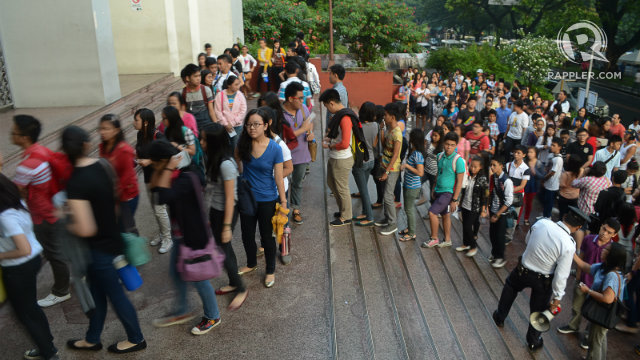SUMMARY
This is AI generated summarization, which may have errors. For context, always refer to the full article.

MANILA, Philippines – “Pag sinabi mong UP, sobrang taas ng tingin.” (When you say you come from UP, people look up to you.)
Julia Andrei Malicdem, 15, is among the thousands of hopefuls taking the University of the Philippines College Admission Test (UPCAT) on August 3 and 4.
As her first choice, she envisions completing a degree in Architecture.
The pressure to pass the exam is greater for her than some of the UPCAT takers. She is following in the footsteps of her elder sister who was accepted in 4 major universities in the country — namely University of the Philippines, Ateneo de Manila University, De La Salle University, and University of Santo Tomas. Julia feels she needs to be at par.
Pressure
“UP si ate, so kailangan ko talagang makapasa sa UP,” Julia explained.
Her sister, who is currently a 2nd year Broadcast Communication major in the university, has said it is crucial for her to get into UP. It will lessen their family’s financial burden especially since the tuition and cost of living in UP are more affordable.
Julia made sure she is well-equipped for the exam. Besides taking her summer review classes, she also took a refresher course and studied religiously two weeks before the test. She even skipped her class a day before the UPCAT to further prepare.
The examination consists of 4 parts: Language Proficiency, Reading Comprehension, Science, and Mathematics.
Last year, around 75,000 students took the test. Of this figure, only around 12,000 students passed. Ironically, not all UPCAT passers pursue UP education due to varying reasons.
Affordable education?
Despite the controversial Socialized Tuition and Financial Assistance Program (STFAP) and tuition fee increases, UP is still cited as one of the universities with the most affordable tuition. Arguably, this is one of the reasons why not all UP passers enroll in the university.
According to a GMA report, the average tuition in most universities costs P30,000 per semester, depending on the degree program.
In PUP, a student only needs at least P666 a year to enroll, with their tuition pegged at only P12 per unit. In contrast, UP students need to save up around P20,000 annually with cost per unit ranging from 0-P1,500 depending on the student’s economic bracket. Compared to private universities, tuition in UP is evidently much cheaper; but, it is expensive compared to the rest of the state universities in the country.
Notwithstanding the drastic increase in miscellaneous and tuition fees, the number of UPCAT takers this year still increased to 83,000 from 75,000 examinees last year.
Aside from affordable tertiary education, the quality education that UP offers remains to be one of its attractive features. As proof, the state university recently landed a spot in the global ranking for universities.
Making the cut
Like Julia, many students from all walks of life aspire to enter UP and be an Iskolar ng Bayan (National Scholar) in the near future. The college entrance test will be the determining factor.
After getting past the first hurdle, select students will be the given the chance to experience the ups and downs of UP life. – Rappler.com
Add a comment
How does this make you feel?
There are no comments yet. Add your comment to start the conversation.